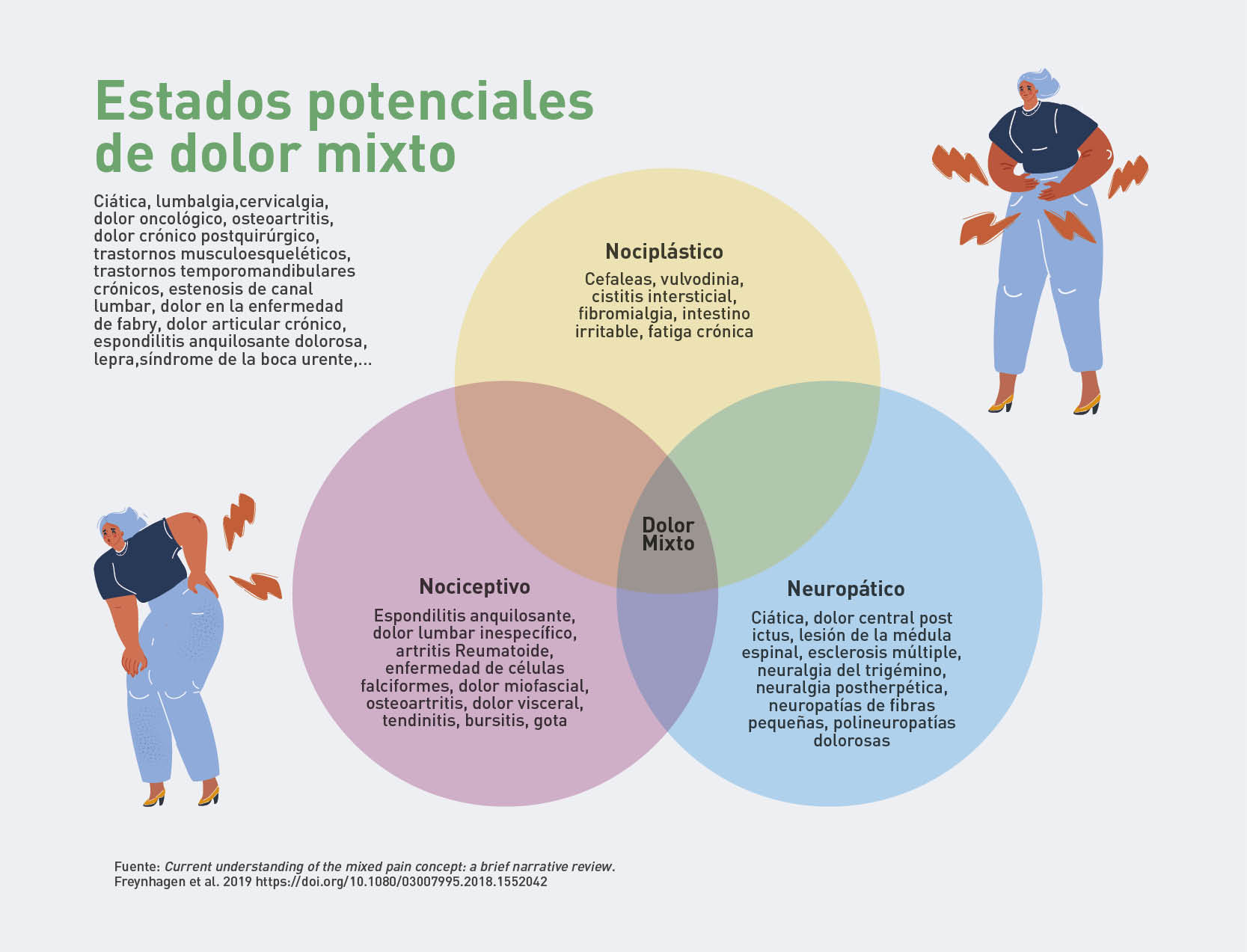Mixed pain: A new paradigm for diagnosing and treating this Symptom
By: Aleida Rueda
Photos: Milagro Castro https://doi.org/10.12804/dvcn_10336.4 2566_num7

By: Aleida Rueda
Photos: Milagro Castro https://doi.org/10.12804/dvcn_10336.4 2566_num7
There are few things as universal as pain. Regardless of origin, economic status, sex or education, millions of people live in pain around the world. If we did the experiment of asking five strangers if they feel pain, at least one would say yes, and that pain would be chronic in 1 in 10. Some already call it a “pandemic of pain.” .
However, in this “pandemic,” no matter how egalitarian it may be, there are differences. There are very well-identified pains: those that result from an injury, such as when someone pricks a foot or burns a finger; or those that are produced by an infection, such as when someone experiences a sore throat or feels the body weakened by a cold. However, there are other, much more complex and difficult-to-characterize pains that have gone unnoticed by much of the medical community for decades.
In the past, the study and treatment of pain focused on the peripheral part of the nervous system, that is, the set of nerves that extends from the spinal cord to all parts of the body. This tendency forced doctors to identify it from physical or nerve injuries, and thus excluded any other type of pain that had seemingly inexplicable or different symptoms
A prime example was patients with fibromyalgia, mostly womenMariano Fernández Fairen, orthopedic surgeon, neuroscientist and professor of Bioengineering of Universidad Internacional de Cataluña, recalls that “for a long time, women with fibromyalgia ere classified as neurotic. They came to the doctors saying that they hurt from their hair to their toenails. Who would believe that?”. “These patients were considered for a long time as the great simulators because they went to the clinic and everything was normal in them; nothing altered was detected in the clinical examinations,” adds, for his part, Carlos Alberto Calderón Ospina, a pharmacologist and head of the Pharmacology Unit at Universidad del Rosario.
Today, it is more unanimously accepted that such pain is as real as that caused by a cut, but at the same time it is much more complex. To describe this complexity, some doctors and researchers have proposed a new concept of pain that does not correspond solely to tissue damage and is not the direct result of injury to the peripheral nervous system. It is, in fact, a combination of different types of pain whose origin could be found even in the central nervous system. This is now known as mixed pain.
Although the term has gained acceptance in the global medical community and has prompted more and more research – there are about 88,400 articles on the web that mention the concept of mixed pain – many questions remain unanswered. Not even the International Asociación Internacional para el Estudio del Dolor(Association for the Study of Pain) (IASP), the scientific organization that promotes research, education, and policy on pain management, has officially recognized the term.
For this reason, specialists who are convinced that mixed pain exists have joined forces. Fernández Fairen and Calderón Ospina are part of a group of 16 authors from nine countries that published a few months ago the article entitled A A Latin American consensus meeting on the essentials of mixed pain (Meeting for the Latin American consensus on the foundations of mixed pain) in the journal Current Medical Research and Opinion (2023). At that meeting, they sought to characterize what thousands of people struggle to describe: complex pain that requires complex treatment.

“For me, the most urgent thing is to disseminate this information, that more colleagues in Latin America start talking about mixed pain, that they propose research projects, diagnostic tools, preclinical models, ways to confirm that it really exists. Pharmaceutical research and development companies to propose valuable, effective and safe pharmacological alternatives for pain management. On the subject of mixed pain the last word is not said. We continue to learn,” asserts Professor Carlos Alberto Calderón from the School of Medicine and Health Sciences at Universidad del Rosario .
A combination of pains
to understand mixed pain we must know, first, that there are three types of pain, these are recognized by the IASP: nociceptive, neuropathic and nociplastic.
bably the most common pain, and the easiest to recognize is the nociceptive. It is the “classic” that occurs when our pain receptors (nociceptors) are activated in response to a stimulus (injury, inflammation, infection).“For example, someone who is playing a football game and suddenly dislocated an ankle. At the time of the injury the person will refer a lot of pain and on the physical examination what we will see is a very swollen ankle. In nociceptive pain there is a very strong correlation between the inflammatory process and the generation of pain; therefore, this type of pain usually responds well to anti-inflammatory drugs such as diclofenac or ibuprofen,” states Calderón Ospina.
The second type is neuropathic pain. It is a chronic symptom secondary to an injury or disease that affects the somatosensory system, that is, the part of the brain that is responsible for collecting information from the environment from stimuli such as touch, sound, light or temperature. This pain is caused by an injury to a nerve fiber that connects environmental signals with our nervous system. It is therefore much more difficult to detect than nociceptive
“When we do the physical examination of the area that the patient refers to as painful, we do not see any alteration, but patients can refer to some very striking phenomena, such as burning, burning or the so-called allodynia (when we feel pain from stimuli that normally do not generate pain). For example, if you touch a patient's arm (without having an injury to the tissue or bone), just with the finger, it can cause terrible pain that can even make them cry,” explains Calderón.
One of the most common examples of neuropathic pain is that caused by shingles, Which is caused by infection with the varicella-shingles virus, the same virus that causes chickenpox and is commonly known as shingles because it causes a rash that follows the pattern of the same spinal nerve, similar to the shape of a snake. “That rash is very painful and can be debilitating. Patients describe it as urning sensation. Sometimes, even the respiratory movements of the rib cage can generate pain,” adds the specialist.
Finally, there is the nociplastic pain. It is the most difficult to recognize because it is basically the result of an alteration of the sensory pathways associated with pain. Unlike the neuropathic, where there is an affectation to the somatosensory system, in this type there is no alteration in it. Everything seems normal. For IASP some of the examples of this pain are chronic fatigue, irritable bowel or fibromyalgia (although other specialists describe the discomfort of fibromyalgia as mixed pain).
Thus, mixed pain is one that encompasses components of nociceptive, neuropathic and nociplastic pain, and therefore until a decade ago it went unnoticed among the global medical community.
“The doctors dedicated to the management of pain had perfectly differentiated and separated the three types, but over time (...) we understood that many painful syndromes, which we previously considered as purely nociceptive, neuropathic or nociplastic, can actually correspond to a picture of mixed pain,” says Calderón Ospina.
This revelation is not simply a change of language or concepts. For many, this is a new way to approach management, especially in Latin America, where 30 percent of the population, about 190 million people according to the Latin American Federation of Associations for the Study of Pain,, suffer from chronic pain.

Seeking consensus
or Uría Guevara, a pain management physician, palliative care specialist, and research professor in the Faculty of Medicine and Surgery at Universidad Autónoma Benito Juárez de Oaxaca (Mexico), recognizing that mixed pain exists is a paradigm shift. He was one of the first Latin Americans to publish an article on the subject, titled precisely Mixed Pain. Changing paradigms, January 2005. In his writing, he used this concept to describe pain that was neither strictly nociceptive nor neuropathic.
“At that time there weren't many articles or studies about it. The pain groups didn't believe in this idea, they were very orthodox. We dared, but unfortunately we published it in a local non-indexed magazine. And if it is not indexed, it does not exist,” says Guevara.
It took more than a decade for the concept of mixed pain to start gaining weight among the medical community. In 2019, at an international meeting in Cancun, Mexico, led by the German specialist in anesthesiology, intensive care and pain treatment, Rainer Freynhagen, a committee was formed with the task of reaching aconsensus about the concept of mixed pain. A year later, the community of Spanish-speaking doctors from Spain and Latin America met again to agree on essential points about mixed pain “from the perspective of the linguistic, cultural and social peculiarities of the population involved,” the authors wrote.
So after a literature review of nearly 600 articles on mixed pain and a face-to-face meeting in Mexico City, in February 2020 the Latin American consensus not only achieved the definition that is now known (the complex condition in which components of nociceptive, neuropathic and nociplastic pain are added), but also put on the table several of the key outstanding questions, including: How to make recommendations for doctors to identify whether or not a person has mixed pain or not?
How can this be achieved?
So far, identifying mixed pain is based on questioning the patient and the doctor's ability to find it. That is why one of the problems associated with this challenge is the fact that there are so few Latin American professionals specialized in pain. “This is a criticism I make of our university systems. The pain in the university is treated as an afterthought,” says Fernández Fairen.
“There is a deficit in pain education,” agrees Guevara. “In every country there are a few pain specialists. In medical schools, fields have been opening up for pain to be well explained and taught to students, but it is not enough. In addition, it must be done in other faculties such as nursing, dentistry or psychology, because all these colleagues have to do with pain, not just the doctor.”
In medical schools we are trained to heal, not to relieve (in the sense of lightening or lightening) pain in patients. We are prepared to diagnose diseases and genetic conditions and see what studies need to be done, but we forget that it is equally or more important to relieve the patient. This is a cultural change in the training of doctors,” explains María Yazde, a pediatric physician who specializes in palliative care at the Pedro de Elizalde, Children's General Hospital, in Buenos Aires.
However, lack of vocational training is not the only challenge. Identifying pain is tremendously complex because it is subjective. Two people may have the same disease or injury and even describe it diametrically differently. For this reason, Carlos Alberto Calderón Ospina opines that “what is missing are the objective tests to confirm that indeed this pain exists and that the two or three pathophysiological mechanisms are occurring simultaneously, in the same body area of the patient and are due to the same cause.”
Some of these tests were proposed in the Latin American consensus, among them having questionnaires with very specific questions to identify if there is more than one type of pain in the patient's experience; using the Facial Action Coding System (Facs, by its acronym in Spanish), which consists of identifying facial expressions as pain signals, which have already been used in various studies to evaluate how people express each type of pain; or to use functional magnetic resonance imaging (MRI), which indirectly measures neuronal activity and can help differentiate and identify mixed pain. In fact, MRI has been used to observe how various parts of the brains of patients with fibromyalgia “light up” when they experience pain, allowing them to shed the label of “malingerers.”
However, there were no decisive answers in the consensus. It is not yet clear to specialists that there is enough evidence on the usefulness of these tests to be able to recommend them. They believe, however, that on the road to the formalization of mixed pain these tools should be used in conjunction with professionals from different disciplines, because a complex problem requires complex responses. And while that evidence is coming, they are sure of one thing: understanding mixed pain helps to better treat people.
The True Paradigm Shift: Listening to the Patient
It has been a couple of years since the international and Latin American consensus on mixed pain was held and the IASP still does not officially include the concept. Some specialists believe this is due to an orthodox and conservative view of the organization's Taxonomy Commission; others believe that it has to do with the difficulty that exists to identify it, as we have already seen.
For none of them, however, it matters much whether the IASP endorses it or not, because, they say, the important thing is in the clinic, in the way the concept is helping to treat patients. “If we have a patient with mixed pain because he has some kind of complex injury and we give him an anti-inflammatory with ibuprofen, we're probably not going to relieve his pain. It is not that we are creating a new treatment, but rather a new approach strategy, and I think that is the substantial change,” explains Dr. Yazde
Mixed pain does not respond to a single medication. “If we have a patient with oncological disease and with severe pain, it can be treated with an opioid, but since there is going to be a neuropathic component, you will also need an adjuvant, that is, a drug that was not strictly designed for the treatment of pain, but that acts in the pathways of modulation of pain, such asgabapentín or the pregabalina (both antiepileptics) or amitriptyline ((for the treatment of mental illness). It is a strategy that complements the action of other drugs,” explains the Argentine doctor.
“I believe that the first benefit for society around knowing that mixed pain exists is that they have better care for their discomfort,” expresses Uría Guevara. “The more you identify and recognize, the more resources you have to take away their suffering through treatment with a multidimensional approach that not only looks at the physical part of the patient, but also at the psycho-affective and social dimensions.”
For Fernández Fairen, one of the changes that mixed pain has brought to the medical community is that it has made them listen more carefully to people. “I say this from the point of self-criticism. One of the flaws we had as doctors was that we decided whether the patient was in a lot of pain or not, the pain was interpreted by us. Now, by relying on the patient, we are much closer to their perception, that is, I am interpreting through what the patient tells me; I am interpreting their painful life experience.”
That is probably the most substantial change that the concept of mixed pain is bringing to medical practice, so far. It is a combination of pain that requires, as never before, a careful follow-up and description by the patient, and a true listening exercise by the doctor.
For Calderón Ospina, it is clear that this is just the beginning. “For me, the most urgent thing is to disseminate this information, that more colleagues in Latin America start talking about mixed pain, that they propose research projects, diagnostic tools, preclinical models, ways to confirm that it really exists. Pharmaceutical research and development companies to propose valuable, effective and safe pharmacological alternatives for pain management. The final word on mixed pain has not yet been spoken. We are still learning.”

When you combine the three different types of pain defined by the International Association for the Study of Pain (IASP) in English) what R. Freynhagen et. al. define as “mixed pain” emerges.